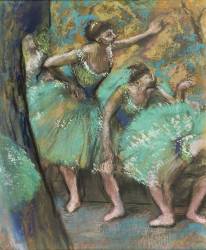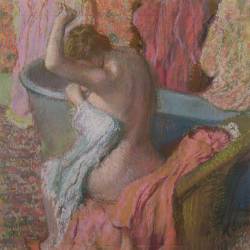Artwork of Edgar Degas
Considered the precursor of the Impressionist style, Edgar Degas left his mark on art history through his creativity, drawn from his knowledge of classical painting and his encounters with the young painters of the second half of the 19th century.
Discover some of Degas' finest paintings, including his oil on canvas "La Classe de danse" (oil on canvas on view at the Musée d'Orsay), an Impressionist painting depicting dancers, a key subject in the artist's work, and "Au café concert des Ambassadeurs" (canvas on view at the Musée d'Orsay), a pastel genre scene inspired by his social life, and "Femme nue, étendue sur le dos" (drawing in the Musée du Louvre), a drawing on paper of a woman from his many sketches of nudes produced at the end of his career.
Treat yourself to the finest Edgar Degas art reproductions available in the catalog, and discover the biography of the father of Impressionism.
Edgar Degas biography
Edgar Degas' youth and training in neoclassicism.
Hilaire Germain Edgar de Gas, better known as Edgar Degas, was born in Paris in 1834 into a cultivated family from the Franco-Italian bourgeoisie. Despite a talent for drawing and an education at the Lycée Louis-le-Grand, where he was taught by the French painter Léon Cogniet, Edgar De Gas was not destined for painting. His father wanted him to study law, but after two years of study, the young Edgar Degas stopped everything to devote himself to drawing and art.
Initially copying paintings and prints by the great masters of painting, his talent for copying academic compositions led him to become a copyist for the Louvre Museum, where he met Manet in the early 1860s. Fascinated by Flemish, Italian and French painting, Degas imbibed the works of Rembrandt, Veronese and Mantegna, as well as more contemporary artists of his time, such as Jean-Auguste-Dominique Ingres, and Romantic painters like Eugène Delacroix. In 1855, far from his bourgeois milieu, the young painter lived precariously in the heart of the Latin Quarter, and continued his training at the École des Beaux Arts de Paris. It was in this second half of the 19th century, at the Beaux Arts Academy, that he further improved his knowledge of academic painting.
Edgar Degas' travels: new encounters and influences.
Until 1960, Degas continued to explore the pictorial movement of academicism, through several trips to his Italian family, during which he drew inspiration from the great Renaissance artists such as Raphael and Botticelli. Although he remained attached to Paris and the Montmartre district, where he met a whole new generation of artists, including Claude Monet, Édouard Manet, Camille Pissarro and Émile Zola, Degas did not hesitate to draw inspiration from his travels, particularly along the English Channel, where he trained in pastel. In 1972, after the Franco-Prussian War, the painter took a trip to the United States, where he visited his family in New Orleans. Already accustomed to painting portraits of family members in France and Italy, Degas took his realistic canvases a step further, focusing on a scene from modern life of the time, as in his painting "Le bureau de Coton à la Nouvelle Orléans", depicting a portrait of his family at work. These subjects, in which contemporary life is depicted in unfiltered realism, would make the painter's works precursors of Impressionism, as with his series of ballerinas, exposing the world of opera as it is, with the rivalries between dancers and the harshness of this milieu.
Edgar Degas, at the heart of the Impressionist movement.
Back in Paris, and unable for over 10 years to exhibit their work at the official Salon, or at the Salon des Refusés, which had been suppressed since 1863, Degas and his friends and artists Claude Monet, Camille Pissarro, Alfred Sisley and Pierre Auguste Renoir, among others, decided to create the "Société Anonyme Coopérative des Artistes Peintres, Sculpteurs et Graveurs", in order to prepare the first Impressionist exhibition of 1874. The effects of light, the genre-based themes and the technique used by the first painters present at the exhibition, forerunners of a new way of painting, made this event a real success with the public and the Parisian art world. Until 1886, the date of the eighth and last Impressionist exhibition, Degas exhibited his work at these shows, alongside Impressionist paintings by contemporaries at the forefront of this artistic movement, such as Paul Gauguin, Paul Cézanne and the Impressionist realist painter Gustave Caillebotte.
From painting to pastels and sculpture, a turning point in the social life of Edgar Degas.
At the end of the 19th century, around 1880, Degas gradually lost his sight. His increasing blindness prompted the artist to change his style, abandoning painting in favor of pastels. It was also during this period that he began making sculptures, the most famous of which, "La Petite Danseuse de quatorze ans", scandalized the whole of Paris with its striking realism, its depiction of the woman, the expression brought to the dancer's face, and the use of real accessories scaled to dress her. At the same time, Degas continued to produce pastels and drawings on paper featuring women, dancers, opera singers or horse-racing jockeys, and depicted scenes from Parisian social life, in which he was frequently seen strolling among the races, at balls and at the opera. Expanding his range of subjects to include portraits of nude women, Edgar Degas caused a scandal as far afield as New York, where controversy swelled from the first exhibition of the artist's work in this new art stronghold. It was in 1892, at the Musée du Luxembourg, that the French painter held his only and last Paris exhibition dedicated to his career.
Ill and ruined, a difficult end to life for Edgar Degas.
Increasingly afflicted by blindness, Edgar Degas, then in his sixties, hardly painted at all, devoting himself almost exclusively to sculpture. Cloistered in his studio on rue Lepic, which he left due to lack of money, notably following the bankruptcy and death of his father, in order to move to a new studio on boulevard de Clichy, Degas hardly ever received visitors. His intransigent character, his view of women, his anti-Semitism and the bitterness caused by his illness made him a difficult personality and one not inclined to receive visitors. He continued, however, to receive a number of artists, as artistic creation and innovation in the art world always aroused a keen interest in the old painter. Renowned for the quality of his collections among collectors, Degas died in 1917 at his home, surrounded by a large number of Impressionist paintings, Japanese prints, canvases by Ingres, Camille Corot, Manet, prints by Paul Gavarni and lithographs by Honoré Daumier, among other famous artists.
The legacy of Edgar Degas.
Painter, draughtsman, sculptor, pastellist and engraver, Edgar Degas varied his art and technical palette throughout his life. Undoubtedly one of the great painters of the second half of the 19th century, with his innovative side leading to paintings and sketches that were unique for their time, but above all by establishing the pictorial trend of Impressionism, his work can be found around the world today, mainly in France and the United States, as evidenced by the painter's works in the exhibition catalog of the Musée d'Orsay in Paris, the Museum of Modern Art in New York (MoMA), the National Gallery of Canada, Pau, Lyon and San Francisco.
Learn more about the life and the works of Edgar Degas.
















































































































































